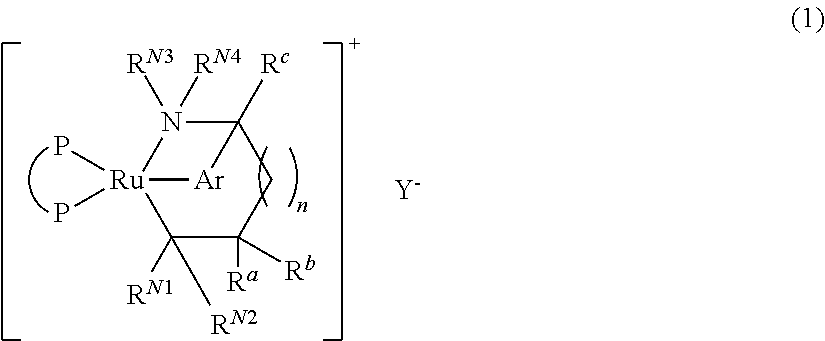Novel ruthenium complex and process for producing optically active alcohol compound using same as catalyst
- Summary
- Abstract
- Description
- Claims
- Application Information
AI Technical Summary
Benefits of technology
Problems solved by technology
Method used
Image
Examples
example 1
(1) Preparation of RuCl[(S)-daipena][(S)-xylbinap]
[0135]
[0136]Under a nitrogen gas, [RuCl2(p-cymene)]2 3.07 g (5.0 mmol), (S)-XylBINAP 7.35 g (10.0 mmol) and methanol 110 mL were added to a 200 mL 4-neck flask. The mixture was heated to 50° C. and stirred for 2 hours to prepare [RuCl(p-cymene) ((S)-xylbinap)]Cl. The reaction solution was cooling down to room temperature, then diethylamine 736 mg (10 mmol) and (S)-DAIPEN 3.48 g (11.1 mmol) were added to the reaction solution, and stirred for 3 hours at 60° C. After concentration, the residue was dissolved in butyl acetate and the precipitated salts were separated by filtration. The filtrate was concentrated and the mixture added with heptane (110 mL) was cooling down to −10° C. The precipitated crystals were filtered to obtain the title compound (11.62 g) with yield of 98%.
[0137]31P-NMR (C6D6): δ
[0138]53.2 (d, J=38.6 Hz), 61.0 (d, J=38.6 Hz)
(2) Preparation of {Ru[(S)-daipena][(S)-xylbinap]}BF4
[0139]
[0140]Under a nitrogen gas, RuCl[(...
example 2
Preparation of {Ru[(S)-daipena][(S)-xylbinap]}PF6
[0143]
[0144]Under a nitrogen gas, RuCl[(S)-daipena][(S)-xylbinap]154 mg (0.13 mmol), AgPF6 32.9 mg (0.13 mmol) and dichloromethane 6 ml were added to the 100 ml Schlenk tube, and stirred at room temperature for 2 hours. The precipitated salt was filtered out from the reaction solution. The filtrate was concentrated and dried in vacuo to obtain the title compound 168 mg, 97% yield.
[0145]31P-NMR (CD3OD): δ
[0146]19.6 (d, J=53.9 Hz), 36.6 (d, J=53.7 Hz)
example 3
Preparation of (R)-1-phenylethanol
[0148]To a 100 mL autoclave with a stirrer bar, acetophenone (1.2 g, 10 mmol) and {Ru[(S)-daipena][(S)-xylbinap]}BF4 obtained from Example 1 above (12.4 mg, 0.01 mmol, 1 / 1000 molar fold of acetophenone) were added. After purging with a nitrogen gas, toluene (5 mL) and 1,8-diazabicyclo[5,4,0]undeca-7-ene (15.2 mg, 0.1 mmol) were added thereto. Subsequently, purging with a hydrogen gas, the mixture was stirred at 30° C. for 3 hours under hydrogen pressure 1 MPa. As a result of analysis of the reaction mixture by gas chromatography (Chirasil-DEX CB), it was found that the conversion rate is 95.4% and optical purity is 98.5% ee.
PUM
| Property | Measurement | Unit |
|---|---|---|
| Optical activity | aaaaa | aaaaa |
Abstract
Description
Claims
Application Information
 Login to View More
Login to View More - R&D
- Intellectual Property
- Life Sciences
- Materials
- Tech Scout
- Unparalleled Data Quality
- Higher Quality Content
- 60% Fewer Hallucinations
Browse by: Latest US Patents, China's latest patents, Technical Efficacy Thesaurus, Application Domain, Technology Topic, Popular Technical Reports.
© 2025 PatSnap. All rights reserved.Legal|Privacy policy|Modern Slavery Act Transparency Statement|Sitemap|About US| Contact US: help@patsnap.com



